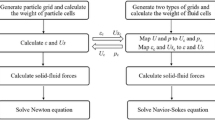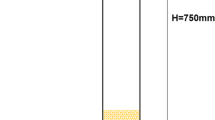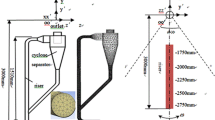Abstract
The present work was carried out to simulate a cold flow model of a biomass gasification plant. For the simulation, a Eulerian-Lagrangian approach, more specifically the multi-phase particle in cell (MP-PIC) method, was used to simulate particles with a defined particle size distribution. Therefore, Barracuda VR, a software tool with an implemented MP-PIC method specifically designed for computational particle fluid dynamics simulations, was the software of choice. The simulation results were verified with data from previous experiments conducted on a physical cold flow model. The cold flow model was operated with air and bronze particles. The simulations were conducted with different drag laws: an energy-minimization multi-scale (EMMS) approach, a blended Wen-Yu and Ergun drag law, and a drag law of Ganser. The fluid dynamic behavior depends heavily on the particles’ properties like the particle size distribution. Furthermore, a focus was placed on the normal particle stress (PS value variation), which is significant in close-packed regions, and the loop seals’ fluidization rate was varied to influence the particle circulation rate. The settings of the simulation were optimized, flooding behavior did not occur in advanced simulations, and the simulations reached a stable steady state behavior. The Ganser drag law combined with an adjusted PS value with (PS = 30 Pa) or without (PS = 50 Pa) increased loop seal fluidization rates provided the best simulation results.















Similar content being viewed by others
Data availability
The data that support the findings of this study are available from the corresponding author, A. Lunzer, upon reasonable request.
Abbreviations
- AR:
-
air reactor, combustion reactor
- BB:
-
bubbling bed
- BCs:
-
boundary conditions
- CFB:
-
circulating fluidized bed
- CFD:
-
computational fluid dynamics
- CPFD:
-
computational particle fluid dynamics
- DFB:
-
dual fluidized bed
- e.g.:
-
exempli gratia
- EMMS:
-
energy-minimization multi-scale (EMMS drag model)
- Eq.:
-
equation
- Fig.:
-
figure
- FR:
-
fuel reactor, gasification reactor
- ILS:
-
inner loop seal
- LES:
-
large eddy simulation
- LLS:
-
lower loop seal
- MP-PIC:
-
multi-phase particle in cell
- PSD:
-
particle size distribution
- SEP:
-
separator
- ULS:
-
upper loop seal
- WYE:
-
Wen-Yu and Ergun (WYE drag model)
- a p :
-
particle acceleration (\( \raisebox{1ex}{$\mathrm{m}$}\!\left/ \!\raisebox{-1ex}{${\mathrm{s}}^2$}\right. \))
- D :
-
drag function (\( \raisebox{1ex}{$1$}\!\left/ \!\raisebox{-1ex}{$\mathrm{s}$}\right. \))
- F :
-
interphase momentum transfer function (N/m3)
- \( \boldsymbol{g} \) :
-
gravitational acceleration (\( \raisebox{1ex}{$\mathrm{m}$}\!\left/ \!\raisebox{-1ex}{${\mathrm{s}}^2$}\right. \))
- p :
-
pressure (Pa)
- P S :
-
constant to calculate τp (Pa)
- t :
-
time (s)
- u f :
-
fluid velocity (m/s)
- u mf :
-
minimum fluidization velocity (m/s)
- u p :
-
particle velocity
(m/s)
- \( {\overline{\boldsymbol{u}}}_{\mathrm{p}} \) :
-
particle mean velocity (m/s)
- x i :
-
spatial variable (m)
- α :
-
constant to calculate τp
- β :
-
constant to calculate τp
- ε cp :
-
close-pack particle volume fraction
- ε f :
-
fluid volume fraction
- ε p :
-
particle volume fraction
- δ ij :
-
Kronecker delta
- m p :
-
particle mass (kg)
- μ :
-
viscosity (\( \raisebox{1ex}{$\mathrm{kg}$}\!\left/ \!\raisebox{-1ex}{$\mathrm{m}\times \mathrm{s}$}\right. \))
- ∇:
-
nabla operator (\( \raisebox{1ex}{$1$}\!\left/ \!\raisebox{-1ex}{$\mathrm{m}$}\right. \))
- ρ f :
-
fluid density (\( \raisebox{1ex}{$\mathrm{kg}$}\!\left/ \!\raisebox{-1ex}{${\mathrm{m}}^3$}\right. \))
- τ D :
-
damping time due to inelastic particle collisions (s)
- τ f :
-
fluid stress tensor (\( \raisebox{1ex}{$\mathrm{N}$}\!\left/ \!\raisebox{-1ex}{${\mathrm{m}}^2$}\right. \))
- τ p :
-
particle normal stress (\( \raisebox{1ex}{$\mathrm{N}$}\!\left/ \!\raisebox{-1ex}{${\mathrm{m}}^2$}\right. \))
References
Schmid J (2014) Development of a novel dual fluidized bed gasification system. TU Wien
Kraft S, Kirnbauer F, Hofbauer H (2017) CPFD simulations of an industrial-sized dual fluidized bed steam gasification system of biomass with 8 MW fuel input. Appl Energy 190:408–420. https://doi.org/10.1016/j.apenergy.2016.12.113
Kuba M, Kraft S, Kirnbauer F, Maierhans F, Hofbauer H (2018) Influence of controlled handling of solid inorganic materials and design changes on the product gas quality in dual fluid bed gasification of woody biomass. Appl Energy 210:230–240
Fotovat F, Abbasi A, Spiteri RJ, de Lasa H, Chaouki J (2015) A CPFD model for a bubbly biomass-sand fluidized bed. Powder Technol 275:39–50. https://doi.org/10.1016/j.powtec.2015.01.005
Liang Y, Zhang Y, Li T, Lu C (2014) A critical validation study on CPFD model in simulating gas-solid bubbling fluidized beds. Powder Technol 263:121–134. https://doi.org/10.1016/j.powtec.2014.05.003
Weber JM, Layfield KJ, Van Essendelft DT, Mei JS (2013) Fluid bed characterization using electrical capacitance volume tomography (ECVT), compared to CPFD software’s barracuda. Powder Technol 250:138–146. https://doi.org/10.1016/j.powtec.2013.10.005
Zhang L, Wang Z, Wang Q, Qin H, Xu X (2016) Simulation of oil shale semi-coke particle cold transportation in a spouted bed using CPFD method. Powder Technol 301:360–368. https://doi.org/10.1016/j.powtec.2016.06.012
Shi X, Sun R, Lan X, Liu F, Zhang Y, Gao J (2015) CPFD simulation of solids residence time and back-mixing in CFB risers. Powder Technol 271:16–25. https://doi.org/10.1016/j.powtec.2014.11.011
Shi X, Wu Y, Lan X, Liu F, Gao J (2015) Effects of the riser exit geometries on the hydrodynamics and solids back-mixing in CFB risers: 3D simulation using CPFD approach. Powder Technol 284:130–142. https://doi.org/10.1016/j.powtec.2015.06.049
Rodrigues SS, Forret A, Montjovet F, Lance M, Gauthier T (2015) CFD modeling of riser with group B particles. Powder Technol 283:519–529. https://doi.org/10.1016/j.powtec.2015.05.020
Wang Q, Niemi T, Peltola J, Kallio S, Yang H, Lu J, Wei L (2015) Particle size distribution in CPFD modeling of gas-solid flows in a CFB riser. Particuology. 21:107–117. https://doi.org/10.1016/j.partic.2014.06.009
Shi X, Lan X, Liu F, Zhang Y, Gao J (2014) Effect of particle size distribution on hydrodynamics and solids back-mixing in CFB risers using CPFD simulation. Powder Technol 266:135–143. https://doi.org/10.1016/j.powtec.2014.06.025
Chen C, Werther J, Heinrich S, Qi HY, Hartge EU (2013) CPFD simulation of circulating fluidized bed risers. Powder Technol 235:238–247. https://doi.org/10.1016/j.powtec.2012.10.014
Clark S, Snider DM, Spenik J (2013) CO2 adsorption loop experiment with eulerian-lagrangian simulation. Powder Technol 242:100–107. https://doi.org/10.1016/j.powtec.2013.01.011
Wang Q, Yang H, Wang P, Lu J, Liu Q, Zhang H, Wei L, Zhang M (2014) Application of CPFD method in the simulation of a circulating fluidized bed with a loop seal, part I-determination of modeling parameters. Powder Technol 253:814–821. https://doi.org/10.1016/j.powtec.2013.11.041
Hamilton MA, Whitty KJ, Lighty JS (2016) Numerical simulation comparison of two reactor configurations for chemical looping combustion and chemical looping with oxygen uncoupling. J Energy Resour Technol 138:042213. https://doi.org/10.1115/1.4033108
Adkins BD, Kapur N, Dudley T, Webb S, Blaser P (2017) Experimental validation of CFD hydrodynamic models for catalytic fast pyrolysis. Powder Technol 316:725–739. https://doi.org/10.1016/j.powtec.2016.11.060
Ma Q, Lei F, Xu X, Xiao Y (2017) Three-dimensional full-loop simulation of a high-density CFB with standpipe aeration experiments. Powder Technol 320:574–585. https://doi.org/10.1016/j.powtec.2017.07.094
Kraft S, Kirnbauer F, Hofbauer H (2017) Influence of drag laws on pressure and bed material recirculation rate in a cold flow model of an 8 MW dual fluidized bed system by means of CPFD. Particuology 36:70–81. https://doi.org/10.1016/j.partic.2017.04.009
Snider DM, Clark SM, O’Rourke PJ (2011) Eulerian-Lagrangian method for three-dimensional thermal reacting flow with application to coal gasifiers. Chem Eng Sci 66:1285–1295. https://doi.org/10.1016/j.ces.2010.12.042
O’Rourke PJ, Snider DM (2014) A new blended acceleration model for the particle contact forces induced by an interstitial fluid in dense particle/fluid flows. Powder Technol 256:39–51. https://doi.org/10.1016/j.powtec.2014.01.084
Snider DM (2001) An incompressible three-dimensional multiphase particle-in-cell model for dense particle flows. J Comput Phys 170:523–549. https://doi.org/10.1006/jcph.2001.6747
Andrews MJ, O’Rourke PJ (1996) The multiphase particle-in-cell (MP-PIC) method for dense particulate flows. Int J Multiphase Flow 22:379–402. https://doi.org/10.1016/0301-9322(95)00072-0
Yang N, Wang W, Ge W, Wang L, Li J (2004) Simulation of heterogeneous structure in a circulating fluidized-bed riser by combining the two-fluid model with the EMMS approach. Ind Eng Chem Res 43:5548–5561. https://doi.org/10.1021/ie049773c
Chhabra RP, Agarwal L, Sinha NK (1999) Drag on non-spherical particles: an evaluation of available methods. Powder Technol 101:288–295
Wen CY YH Yu (1966). Mechanics of fluidization. In: chemical engineering Progress symposium series. Pp 100–111
Martinovic D (2013) Kaltmodellversuche und MSR-Konzept einer Zweibett-Wirbelschicht-Vergasungsanlage. TU Wien
Gidaspow D (1994) Multiphase flow and fluidization: continuum and kinetic theory descriptions. Academic press
Ergun S (1952) Fluid flow through packed columns. Chem Eng Prog 48:89–94
CPFD Software LLC. (2018) Barracuda Virtual Reactor User Manual
Kraft S (2017) Investigation of particle mixing in dual fluidized bed gasification systems by means of cold flow modelling and computational methods. TU Wien
Bi HT, Grace JR (1995) Flow regime diagrams for gas-solid fluidization and upward transport. Int J Multiphase Flow 21:1229–1236. https://doi.org/10.1016/0301-9322(95)00037-X
Author information
Authors and Affiliations
Corresponding author
Ethics declarations
Conflict of interest
Not applicable.
Code availability
Not applicable
Additional information
Publisher’s Note
Springer Nature remains neutral with regard to jurisdictional claims in published maps and institutional affiliations.
Rights and permissions
About this article
Cite this article
Lunzer, A., Kraft, S., Müller, S. et al. CPFD simulation of a dual fluidized bed cold flow model. Biomass Conv. Bioref. 11, 189–203 (2021). https://doi.org/10.1007/s13399-020-01229-4
Received:
Revised:
Accepted:
Published:
Issue Date:
DOI: https://doi.org/10.1007/s13399-020-01229-4




